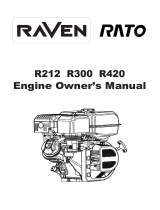
CONTENTS
1. SAFETY
INFORMATION
..........................................................................
.3
Safety
label locations
.............................................................................
.3
Safety
information
..................................................................................
.4
2. COMPONENT
IDENTIFICATION..
............................................................
.8
3. PRE-OPERATION
CHECK
......................................................................
10
Engine
oil
..............................................................................................
10
Transmission
oil ........... .
........................................................................
1
1
Air
cleaner ............................................................................................
.l 1
Fuel
......................................................................................................
.12
Tire
pressure
........................................................................................
.15
Wheel
clevis pin
...................................................................................
.15
Tines
and fasteners.. ............................................................................
.16
4. STARTING
THE
ENGINE .......................................................................
.17
5. TILLER
OPERATION
..............................................................................
.20
Handlebar
height adjustment
...............................................................
.20
Tilling
depth adjustment
.......................................................................
.21
Gear
selection
......................................................................................
.22
Main
clutch operation
..........................................
. ................................
.23
Differential
lock operation
(FR750
only)
...............................................
.24
Turning
(when
moving) ........................................................................
.25
Tilling
work
...........................................................................................
.26
High
altitude operation
.........................................................................
.27
6. STOPPING
THE
ENGINE
.......................................................................
.28
7. TRANSPORTING
....................................................................................
.30
8. MAINTENANCE
......................................................................................
.31
The
importance of
maintenance..
.........................................................
.31
Maintenance
safety ..............................................................................
.32
Emission
control
system
......................................................................
.33
Maintenance
schedule
.........................................................................
.35
Engine
oil change.. ...............................................................................
.36
Air cleaner service
................................................................................
.37
Sediment cup cleaning
.........................................................................
.39
Spark
plug service..
..............................................................................
.40
Spark arrester
maintenance
(optional equipment)
...............................
.42
Throttle
cable
adjustment .........
. ...........................................................
.44
Main
clutch cable
adjustment
...............................................................
.45
Differential
lock cable
adjustment
(FR750
only) ...................................
.46
Drive
belt adjustment ...........................................................................
.47
Tine
inspection
and replacement
.........................................................
.50
9. STORAGE
...............................................................................................
.54
Preparation for storage
........................................................................
.54
Storage..
...............................................................................................
.58
Removal
from
storage ..........................................................................
.58
10.
TROUBLESHOOTING
............................................................................
.59
11 . SPECIFICATIONS..
..................................................................................
61
12. WARRANTY SERVICE
INFORMATION
..................................................
62
13. INDEX.. ....................................................................................................
.63
2
























